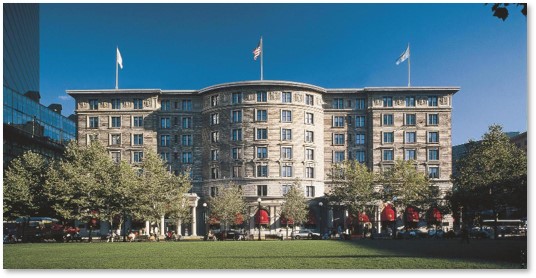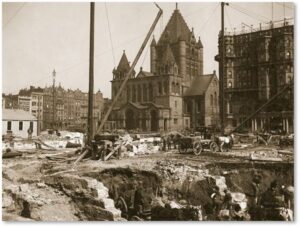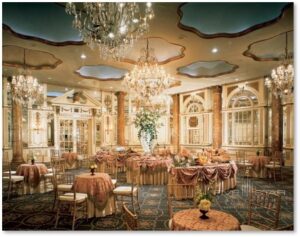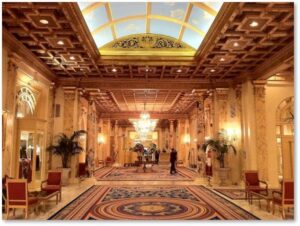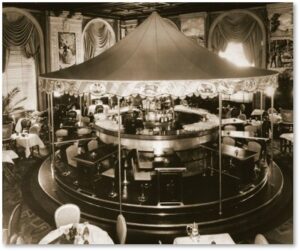She owns the southern edge of Copley Square yet is often overlooked in favor of her showier neighbors. Like any respectable Boston matron, the Fairmont Copley Plaza Hotel projects a stately, confident, and self-assured presence. The building, which fills the block along St. James Street between Trinity Place and Dartmouth Street, goes quietly about its business of welcoming its guests, as it has done since 1912.
Yet the hotel has solid architectural chops and the magnificent lobby holds its own, between the ornate “People’s Palace” of the Boston Public Library and the gorgeous interior of Trinity Church.
The Museum Moves On
The Copley Plaza Hotel rose on the space that formerly housed the first Boston Museum of Fine Arts (1876), designed by Sturgis and Brigham. When the museum moved down Huntington Avenue to its current location in 1910, its Ruskinian Gothic building, only 43 years old, was demolished.
That elaborate terra-cotta and brick structure gave way to something more modern and elegant without being ostentatious. (No Boston grande dame would ever be ostentatious, at least not on the street.)
Where the museum was vertically oriented and dark red, the hotel has a horizontal layout and is made of light stone.
Stabilizing the Foundation
The architectural commission for the seven-story Italian Renaissance Revival structure went to Henry Janeway Hardenbergh, the New Yorker who designed that city’s Plaza Hotel and Dakota apartment building, as well as the Willard Hotel in Washington, DC. Clarence Blackall, the local architect behind the Little Building and many of Boston’s theaters, collaborated on the project.
Mr. Hardenbergh built for the long term with heavy, conservative masonry designs that delivered “dependable solidity.” He and Mr. Blackall stabilized the hotel’s E-shaped foundation with 8,000 wooden pilings. Engineers drove these 70 feet down through the Back Bay’s gravel fill to the underlying glacial blue clay. Construction took 16 months and $5.5 million — $156,470,510 today, if you could find the materials. Laborers earned 35 cents an hour and worked seven days a week.
Renaissance Revival Style
The hotel has a swell-front facade of rusticated limestone and pale brick. Two entrance porticoes flank this bowfront, one holding the hotel’s main entrance while the other provides an exit to St. James Street. Rows of arched windows line the ground floor.
String courses stretch above the first and second floors and separate the sixth and seventh floors. Medallions decorate the spaces between windows on the seventh floor, some containing the back-to-back letter Ps that Mr. Hardenbergh devised for the Plaza Hotel in New York City. He also used them on the inside and the doorknobs.
The marbled, gilded and mural-decorated public spaces, culminating in the grand ballroom provide all the glitz and glamor the exterior denies. Peacock Alley, the hotel’s 5,000-square-foot lobby, welcomes visitors to the Fairmont Copley Plaza with a 21-foot-high coffered and gilded ceiling. The AIA describes the interior as “lavish and theatrical.” I would have preferred the term Baroque to give weight to the beauty found in the lobby, ballroom, restaurants, bar, and function rooms tucked away behind the classical façade.
The Copley Plaza’s Innovations
The Copley Plaza hotel introduced many innovations in the hospitality industry as the first:
- Hotel with an international reservations system
- Completely air-conditioned hotel in Boston
- Hotel anywhere to accept credit cards
- Hotel to offer direct telephone dialing for guests
The Famous Residents
As with many of Boston’s hotels, the Fairmont Copley Plaza boasts many famous residents. They include every major U.S. President since Taft, (most recently, Barack Obama) royalty and celebrities, foreign dignitaries and heads of state.
- On the new hotel’s opening day, Mayor of Boston John F. “Honey Fitz” Fitzgerald, President Kennedy’s grandfather, presided over a reception for more than 1,000 guests. These included local and national dignitaries, civic leaders, captains of industry, and stage and movie stars. A room cost $3.50 (about $100 today) and the hotel’s elegant rooms were booked 16 months in advance.
- Artist John Singer Sargent had a suite of rooms there from 1919 until his death in 1925. He could often be seen lunching with his patron, Isabella Stewart Gardner. Mr. Sargent not only painted several of his masterpieces while in residence, he even used one of the hotel’s elevator operators—Thomas McKeller—as the model for the Greek god Apollo in his renowned mural, Boston’s Apollo.
- Harry Houdini stayed at the hotel in 1924 when he came to Boston to debunk Mina Crandon, “The Witch of Lime Street,” in her quest to prove to Scientific American that she could manipulate spirits of the dead.
- Actors Richard Burton and Elizabeth Taylor chose the Copley Plaza for their second honeymoon in 1975. Tom Cruise and Frank Sinatra have also stayed here. In addition, the Fairmont Copley Plaza has served as a location for several movies, including “Live By Night,” “American Hustle,” “The Firm” and “Blown Away.”
Historical Events
The Copley Plaza’s guests and customers also participated in historical events.
They celebrated the end of Prohibition in 1933 at The Copley Plaza’s iconic Merry-Go-Round Bar. This venue, which featured a working merry-go-round, remained a popular gathering place through the 1970s. Pieces of the Merry-Go-Round Track have been preserved in the floor of OAK Long Bar + Kitchen.
In World War II, the hotel did their part for the war effort by ensuring that its elevator “boys” had to be over 65, to free younger men for military service.
Transcending Difficulties
The Copley Plaza Hotel went through a difficult period in the 20th century and had declined by the mid-1900s. The Sheraton Corporation owned it from the 1950s through the 1970s, operating as the Sheraton-Plaza Hotel. The company placed a neon sign on the roof. (The Boston matron is aghast!) Under that name, it was more of a budget hotel. It in 1972 the John Hancock Mutual Life Insurance Company purchased it and restored the historic building.
In 2012 it received a $20 million renovation. The project remodeled the 383 guestrooms and suites, enhanced meeting rooms and public spaces, and added a new restaurant and a 3,000-square-foot rooftop health club. Today Fairmont Hotels and Resorts operates it as the Fairmont Copley Plaza.
The Grande Dame and I
While I have never stayed at the Fairmont Copley Plaza, the grande dame and I are well acquainted. I have been fortunate enough to attend glamorous professional events in its function rooms. It has also served as my first stop (pit stop) before leading a tour of the Back Bay for Boston By Foot. I have walked through the impressive Peacock Alley many times, enjoying its fresh flowers, gilded décor and enormous paintings.
The Fairmont Copley Plaza has changed little on the outside since its opening and is a member of Historic Hotels of America. This program of the National Trust for Historic Preservation celebrates historic hotels in the U.S. selected the Fairmont Copley Plaza as “Historic Hotel of the Year” in 2019. You can’t get one of the hotel’s 393 rooms for $100 these days, though. They start at over twice that and go up from there.
Related Post: The Kensington Lions
If you would like to know more about how the stately golden lions came to guard the main entrance to the Fairmont Copley Plaza, read this post from my Bronze Menagerie series.
